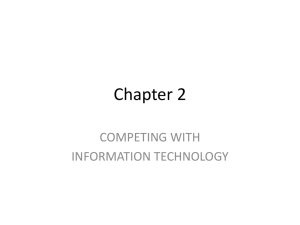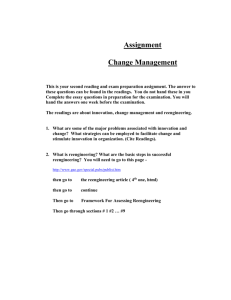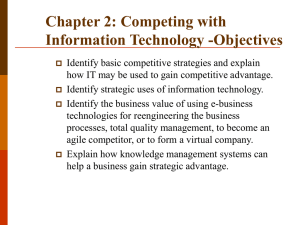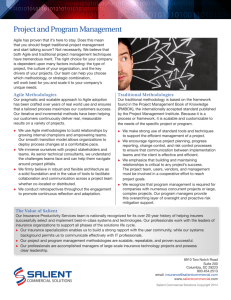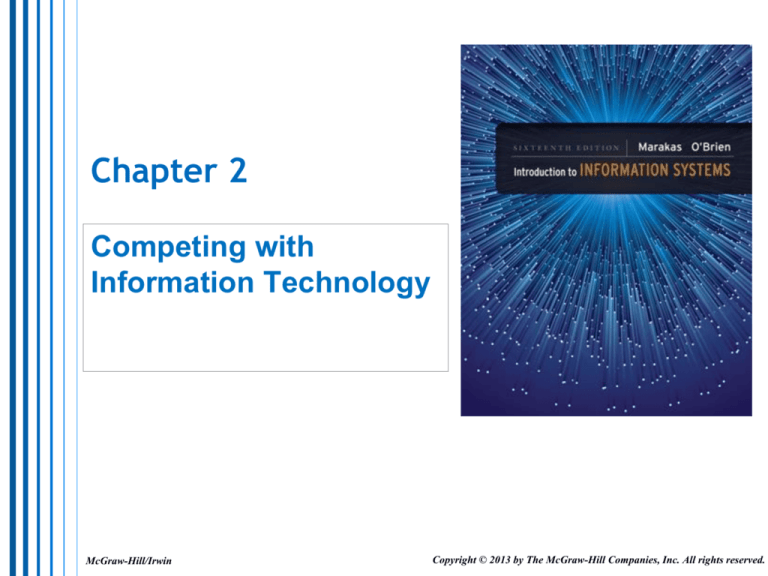
Chapter 2
Competing with
Information Technology
McGraw-Hill/Irwin
Copyright © 2013 by The McGraw-Hill Companies, Inc. All rights reserved.
Learning Objectives
Identify several basic competitive
strategies and explain how they use
information technologies to confront
the competitive forces faced by
business.
Identify several strategic uses of
Internet technologies and give
examples of how they can help a
business gain competitive advantages.
2-2
Learning Objectives
Give examples of how business
process reengineering frequently
involves the use of Internet
technologies.
Identify the business value of using
Internet technologies to become an
agile competitor or form a virtual
company.
Explain how knowledge management
systems can help a business gain
strategic advantages.
2-3
Section 1
Fundamentals of Strategic Advantage
2-4
I. Strategic IT
Technology is now the actual cause and
driver of business strategies
Technology is no longer an afterthought in
forming business strategies
2-5
II. Competitive Strategy Concepts
Strategic Information Architecture – the
collection of strategic information systems
that shape/support the competitive
position/strategies of a firm
2-6
II. Competitive Strategy Concepts
Competitive Forces (Porter)
Rivalry of Competitors
Threat of New Entrants
Threat of Substitutes
Bargaining Power of Customers
Bargaining Power of Suppliers
Competitive Strategies
Cost Leadership Strategy
Differentiation Strategy
Innovation Strategy
Growth Strategy
Alliance Strategy
2-7
II. Competitive Strategy Concepts
2-8
III. Strategic Uses of Information Technology
Other Strategic Initiatives
Locking by Building Relationships
Lock In Customers
Lock In Suppliers
Lock Out Competitors
Switching Costs – make customers/supplier
dependent on mutually beneficial inter-enterprise
information systems
Raise Barriers to Entry – discourage or delay
other firms from entering a market
Leverage Investment in IT – develop new
products and services that are not possible
without strong IT capabilities
2-9
II. Competitive Strategy Concepts
2-10
II. Competitive Strategy Concepts
2-11
II. Competitive Strategy Concepts
2-12
Boeing: Saving Big by Cutting Imaging
Costs
How much was Boeing spending on
annual imaging services costs?
What did they do to solve this
problem?
How much did they save annually by
making these changes?
2-13
Competitive Advantage and
Competitive Necessity
What is Competitive Advantage?
What is the problem with competitive
advantage?
What is Competitive Necessity?
What is the relationship between
Competitive Advantage and
Competitive Necessity?
2-14
Competitive Advantage and
Competitive Necessity
2-15
IV. Building A Customer-Focused
Business – Strategic Focus on
Customer Value
Recognizing
that Quality, not
Price, has become the primary
factor in a customer’s
perception of value
Internet
technologies can make
customers the focal point of ebusiness applications
2-16
IV. Building A Customer-Focused
Business – Strategic Focus on
Customer Value
2-17
Universal Orlando: IT Decisions Driven
by Customer Data
What does McKenna see as the way to
fulfill her contribution to decision making?
According to McKenna, it’s more critical
than ever for CIOs to do what?
Why Is Universal interested in drill down?
2-18
V. The Value Chain and Strategic IS
Value Chain – the series/chain/network of
activities that add value to
products/services
Primary Processes – directly related to
manufacture of products or delivery of
services
2-19
V. The Value Chain and Strategic IS
Support Processes – business activities
that that support daily operations of the
firm and indirectly contribute to
products/services
Value Chain Examples
The Value Chain Concept can help identify
where and how to apply strategic
capabilities of IT
2-20
Section 2
Using Information Technology for
Strategic Advantage
2-21
I. Strategic Uses of IT
Support everyday operations (nonstrategic)
Use IT as a major competitive
differentiator (strategic)
2-22
II. Reengineering Business Processes
Business Process Reengineering
(BPR)
High Potential Payback, but High Risk of
Failure
Organizational Redesign
Process Teams
Case Managers
The Role of Information Technology –
IT plays a major role in BPR
2-23
II. Reengineering Business Processes
2-24
To Build or to Buy – Is That Really the Question?
What is the traditional answer?
Why might reality be more complicated?
Why does VISA custom build in-house?
Why does VISA busy of-the-shelf?
2-25
III. Becoming An Agile Company
Business today is changing from mass
market products/services that were
standardized, long-lived, informationpoor, exchanged in one-time
transactions to global competition with
niche markets that are individualized,
short-lived, information-rich,
exchanged on an ongoing basis with
customers
2-26
III. Becoming An Agile Company
4 Basic Strategies:
Customer Perception of Goods and Services
Partnering with Customers, Suppliers, and Even
Competitors
Organize to Thrive on Change and Uncertainty
Leverage Impact of Personnel and Their
Knowledge
Types of Agility
Customer
Partnering
Operational
2-27
III. Becoming An Agile Company
2-28
IV. Creating A Virtual Company
Virtual Company – Uses the Internet,
intranets and extranets to create virtual
workgroups and support alliances with
business partners
Virtual Company Strategies
Share infrastructure and risk with alliance partners
Link complimentary core competencies
Reduce concept-to-cash time through sharing
Increase facilities and market coverage
Gain access to new markets and share market or
customer loyalty
Migrate from selling products to selling solutions
2-29
IV. Creating A Virtual Company
2-30
IV. Creating A Virtual Company
2-31
Sysco: Transforming a Company with
the Help of IT
What is Sysco’s new project?
What do they hope to accomplish with
this?
What is the most important key to a
project of this scope?
Why SAP?
2-32
V. Building a Knowledge-Creating
Company
One sure Source of Competitive
Advantage is Knowledge
The Business of a “KnowledgeCreating” company is Continuous
Innovation
2-33
V. Building a Knowledge-Creating
Company
Explicit Knowledge – written down or
stored on computers
Tacit Knowledge – “how-to”
knowledge residing in the workers;
very important but little incentive to
share this information so it is never
written down
2-34
V. Building a Knowledge-Creating
Company
Knowledge Management – 3 levels:
Enterprise Knowledge
Information Creation, Sharing, and Management
Document Management
2-35
VI. Knowledge Management Systems
Making personal knowledge available
is the central activity of a knowledgecreating company
This takes place continuously at all
levels of the organization
Knowledge management has become
a major strategic use of information
technology
2-36
VI. Knowledge Management Systems
Goal of Knowledge Management – to create,
organize, and disseminate important
business knowledge whenever and wherever
it is needed in the organization
Knowledge Management systems:
Facilitate organizational learning and knowledge
creation
Provide rapid feedback top knowledge workers
Encourage employee behavioral change
Significantly improve business performance
2-37
Goodwin Proctor Makes a Strong Case
for Knowledge Management
What were G.P.’s attorneys spending their
time doing?
What is the Matter Page System?
In what way does Matter Pages help an
attorney?
What other technologies are being
incorporated into the system?
How will these technologies assist users?
2-38



